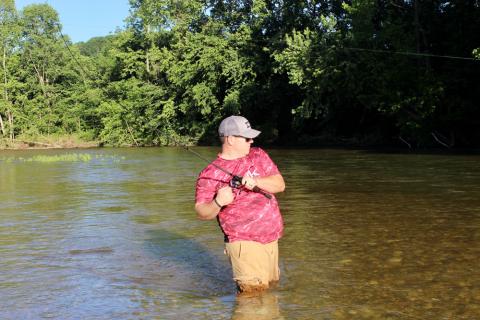provided by John E. Phillips
Thirty-two-year-old Drew Benton from Panama City, Florida, has been tournament fishing for 16 years. He began his tournament fishing career on the FLW Circuit and fished three seasons there, then moved to the Bassmaster Elite Series in 2016 and has qualified for the Bassmaster Classic for 3 years. Drew Benton finished third in the Bassmaster Elite Series Lake Eufaula tournament with 88 anglers on June 13, 2020, catching a total of 82 pounds, 4 ounces of bass to win $20,000.

I’ll use four different lures when I’m fishing deep-river ledges like you see on the Tennessee River. I’ll fish a deep-diving crankbait like a Strike King 5XD or 6XD, a Nichols Lures’ Magnum Spoon, a dropshot worm or a swimbait, like a Big Bite Suicide Shad.
When I’m fishing a spoon, I let the lake and the ledge dictate what size and color of spoon I’ll be fishing. For example, on the Tennessee River, the Nichols Lures Ben Parker Magnum 8-inch Spoon is king for ledge fishing. If I’m fishing lakes like Eufaula or Seminole, where giant gizzard shad don’t live like they do on the Tennessee River, I’ll fish a 6-inch Ben Parker Mini Magnum Spoon or a 4-3/4-inch spoon called the Lake Fork spoon. My favorite colors on spoons will be chrome on one side and a painted shad color on the other side, because this two-sided color spoon breaks-up the flash of the chrome with the color of a shad, as that spoon wobbles, falling toward the bottom. I fish all the spoons on Seaguar’s Invizx 20-pound -fluorocarbon test.
While fishing spoons, I’ll cast the spoon out and feed it line as it falls in a straight vertical drop all the way to the bottom. When the spoon hits the bottom, I’ll jerk it up off the bottom and let it fall back. It will flutter back to almost the same place where it hit the bottom, I’ll continue to retrieve by snatching the spoon up and letting it fall back to the bottom on the slack line. When fishing a spoon, you’ve got to be a line watcher, because most often the bass will take the bait as it falls back to the bottom. The ledge may be 10 or 12 feet to its top, so I’ll work the spoon over the ledge and let it fall. I have caught bass in water as deep as 20-feet deep fishing this method. I believe a spoon can catch bass in water depths from 5 to 50 foot deep. Another good thing about fishing the spoon is it’ll catch anything. If I’m driving around graphing the bottom, and I spot a big school of fish, I can drop a spoon on top of them and catch whatever is in that school. If you’re fishing a really small spoon, you can catch just about any type of fish in a lake.
One time when I was fishing on Lake Seminole, I spotted a big school of fish and I thought, “Wow! That’s the motherload of bass.” First I threw a crankbait to the school and couldn’t get a bite, and then I threw a plastic worm and still got no bite. But when I cast a spoon to the school, my rod bowed, and the drag on my reel started slipping. I thought that the bass that took my spoon would weigh 8-12 pounds. However, when I got my monster fish to the boat and weighed it, I’d caught a 20-pound blue catfish. I realized right away what I was graphing was not a motherload of bass, but was in fact a motherload of catfish.

On the Bassmaster’s Elite Circuit, just about every angler will have some type of spoon tied on a rod out on his casting deck. But, weekend anglers may have forgotten what a powerful lure a spoon is. Spoon fishing is a technique that many of our grandfathers used to fish. One of the big advantages to fishing a spoon is that anybody can fish it. All you do is cast it out, let it fall on a slack line and then when it stops falling, jerk it off the bottom, and let it fall back. Using this technique, the spoon will work every time you fish it.
To set the hook after you see a twitch on your line when fishing a spoon, simply reel-up the slack in your line, set the hook, and reel in the bass. If you’re fishing a Nichols’ Magnum Spoon or even a Mini Magnum Spoon, once you’ve hooked a bass you’ve got to keep it coming to the boat. Every time a bass jumps, it has a real good chance of throwing that spoon that will be flouncing around while in that fish’s mouth, possibly knocking the hook loose. I try and swing the bass into the boat as fast as I can after I hook one.
Most of the time when I’m ledge fishing, I’ll catch my bass in 12-15 foot deep water. When I find a school of bass holding on a ledge, the first lure I’ll throw to them is a crankbait that’ll dive to the depth where they’re holding. If I don’t catch a bass, then I assume that school may be dormant and not feeding. So, the next lure I’ll throw to them will be the spoon, because a spoon has the ability to fire-up a school of bass and cause them to start feeding actively. The next lure I’ll cast to them will be a 10-inch worm that I’ll fish slowly. If the bass won’t hit the big worm, then I’ll cast a dropshot rig.



























